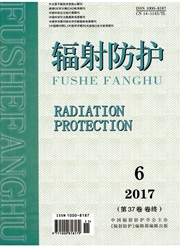

 中文摘要:
中文摘要:
介绍了2006-2010年我国部分地区居室氡浓度调查的方法和结果。本次调查采用固体核径迹探测器,基本上3个月为一个测量周期,分4个季节进行探测器的布放与回收,多数地区进行了为期1年的测量。共有1个省和7个城市参加了此次调查,测量房间数共计2029个,涉及省市人口约占全国总人口的12%。氡浓度范围5.3—183.0Bq·m^-3,按样本量加权均值为(32.6±5.2)Bq·m^-3,按人口加权均值为(30.7±4.3)Bq·m^-3。氡浓度超过100Bq·^-3的房间(36间)约占总调查房间的1.8%。本次调查结果与20世纪八、九十年代测量结果的比值范围为1.00—3.12,按各城市人口加权均值为1.80。同时对调查地区城镇/农村、不同建筑年代、不同楼层、不同建筑类型、不同地面和墙体材料居室内氡浓度进行了比较分析,分析了调查地区居室内氡浓度季节变化。
 英文摘要:
英文摘要:
The paper reports the method and main results of investigation on radon in dwellings in some parts of China. Measurements of indoor radon concentrations were performed in one province and seven cities for one year, with every 3 months for one period, corresponding to spring, summer, autumn and winter seasons, using solid state nuclear track detectors. It involves 2 029 dwellings in total, and the population of the cities accounts for 12% of China. The investigation shows that the range of indoor radon concentrations is 5.3-183.0 Bq·m^-3, the average values with sample-weighted and population-weighted are ( 32.6 ± 5.2) Bq·m^-3 and ( 30.7 ± 4.3 ) Bq·m^-3 respectively. Radon concentrations in dwellings with different building ages, types and materials in urban and rural areas were compared in this paper, and seasonal variation of radon in dwellings were compared also.
 同期刊论文项目
同期刊论文项目
 同项目期刊论文
同项目期刊论文
 期刊信息
期刊信息
